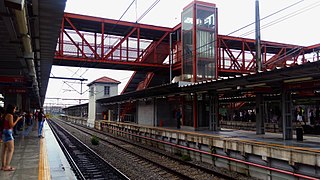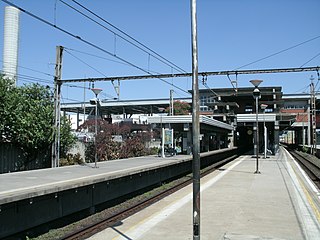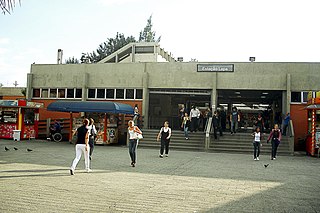
Luz Station is a commuter rail and intercity rail station in the Bom Retiro district of São Paulo, Brazil, serving RFFSA, the intercity rail network of Brazil, CPTM Line 7-Ruby, Line 11-Coral and Line 13–Jade (Airport-Express). It has subway connections to São Paulo Metro Line 1-Blue and ViaQuatro Line 4-Yellow via its underground metro station of the same name.

The Júlio Prestes Cultural Center, which is located in the Júlio Prestes Train Station in the old north central section of the city of São Paulo, Brazil, was inaugurated on July 9, 1999. The building has been restored and renovated by the São Paulo State Government, as part of the downtown revitalization in that city. It houses the Sala São Paulo, which has a capacity of 1498 seats and is the home of the São Paulo State Symphonic Orchestra (OSESP). It is a venue for symphonic and chamber presentations.

Bom Retiro is a central district in the city of São Paulo, Brazil. It is primarily commercial but has industrial and residential areas.

Transport in São Paulo plays a key role in the daily lives of the people of São Paulo and offers various methods of public transport that are offered in the city, including a complex bus system run by SPTrans, and various subway and railway lines. A contactless smartcard is used to pay fares for the buses, subway, and railway systems. São Paulo also has three airports.

Calmon Viana is a train station on CPTM Lines Line 11-Coral and 12-Sapphire, located in Calmon Viana, district of Poá.

Comendador Ermelino is a train station belonging to CPTM Line 12-Sapphire, located in Ermelino Matarazzo. Beside the station is located the neighbourhood's industrial park.

Osasco is a train station on ViaMobilidade Lines 8-Diamond and 9-Emerald, located in the city of Osasco.

Presidente Altino is a train station on ViaMobilidade Lines 8-Diamond and 9-Emerald, located in the district of President Altino in the city of Osasco.

Palmeiras-Barra Funda, also known only as Barra Funda, is a train station on CPTM Line 7-Ruby and ViaMobilidade Line 8-Diamond, in the district of Barra Funda in São Paulo.

Água Branca is a train station on CPTM Line 7-Ruby, in the district of Água Branca in São Paulo. In the future, it will be connected with São Paulo Metro/Move São Paulo Line 6-Orange and CPTM Line 8-Diamond and Regional Trains.

Vila Clarice is a train station on CPTM Line 7-Ruby, located in the district of Pirituba in São Paulo.

Jaraguá is a train station on CPTM Line 7-Ruby, in the district of Jaraguá in São Paulo. It is the only CPTM station that has platforms built in different locations. The station is split in two by Estrada de Taipas. This way, the level crossing is open faster for the local traffic and avoid delays.

Lapa, originally named Km 7, is a train station on ViaMobilidade Line 8-Diamond, located in the district of Lapa in São Paulo.

Imperatriz Leopoldina is a train station on ViaMobilidade Line 8-Diamond, located in the district of Vila Leopoldina in São Paulo.

Comandante Sampaio is a rail station belonging to ViaMobilidade Line 8-Diamond, located in the city of Osasco, in the Km 18 borough.

Quitaúna is a train station, belonging to ViaMobilidade Line 8-Diamond, located in the municipality of Osasco.

General Miguel Costa is a train station, belonging to ViaMobilidade Line 8-Diamond, located in the municipality of Osasco, Brazil.

The São Paulo Metropolitan Train is a public transit rail system implanted in Greater São Paulo, serving 23 of its 39 municipalities. It has 273 km (170 mi) of length, 7 lines and 94 stations, transporting approximately 3 million passengers per day. Currently, it is operated by the state-owned company Companhia Paulista de Trens Metropolitanos (CPTM), but two of the lines were auctioned to ViaMobilidade, which began operating their administrations in January 2022.

The Bauru Station (NOB) is the starting point of the Estrada de Ferro Noroeste do Brasil (NOB) ("Brazil's Northwest Railroad"). Opened in 1906, it consisted of a simple wooden building attached to the Bauru Station of the Sorocabana Railroad. With the growth of traffic, the wooden building was temporarily extended until the construction of a definitive station opened in 1939. The last long-distance passenger trains left the station in 2001. In 2006, the administration was transferred to the Bauru City Hall, which has been managing it since then.

The CPTM Series 7000 is a class of electric multiple units part of the São Paulo Metropolitan Trains rolling stock. It was built by CAF and began operating in 2010.

























